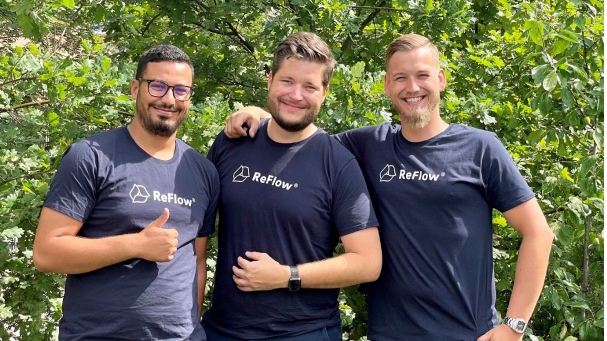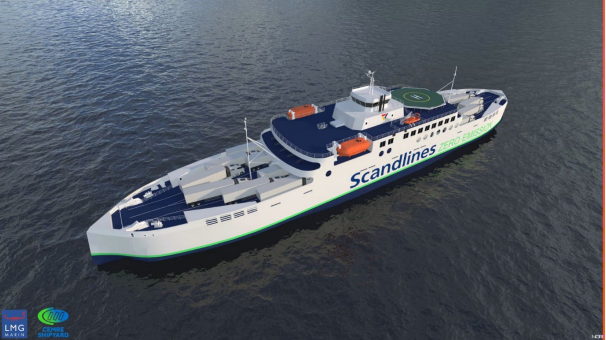Press Release: Scandlines has chosen the Danish climate tech startup ReFlow to develop advanced climate twins of its latest “Zero-emission” ferry design using cutting-edge life cycle assessment (LCA) methodology.
The steel is currently being cut at Cemre Shipyard for the zero-emission vessel contracted by Scandlines for the Puttgarden-Rødby route. Over the following months, ReFlow will build a detailed life-cycle model representing the vessel from its construction to its end of life many years from now. The model will show the environmental impact of the ferry, not only in its use but also from its construction at Cemre Shipyard along with the installed equipment. The digital “climate twin” will make it possible for Scandlines to run simulations on the use of new green technology on the ferry something that is nearly impossible today.
A future-proof investment
Life Cycle Assessment (LCA) is a holistic approach to assessing the environmental impact. It can include all life cycle stages of a vessel and not just the fuel consumption that is common practice in the maritime industry. Incorporating all life cycle stages, the shipowner will get a complete overview of the vessel’s emissions in its entire life, including the fuel consumption.
“Our new zero-emission vessel will be electrically powered, so it makes good sense for us to look at the entire life cycle and understand the remaining emissions so they can be improved over time,” states Fini A. Hansen, VP Fleet, Scandlines.
What is a digital twin?
A digital twin is a digital representation of physical products, in this case, a ferry. The digital twin concept became famous in 2010 by NASA, allowing for digital modeling of its space ferries before departure. Today the use of digital twins is widely shared in many industries as it allows for low-cost simulations before installing expensive equipment.
An industry first
The ferry will be environmentally assessed using ISO-backed Life Cycle Assessment methodology – a tool well-known in other industries like automotive and construction but very new to the maritime industry.
“We are very excited about the new cooperation and also looking forward to the world premiere of applying life cycle assessment to a complete ferry – it is an industry first to our knowledge,” states Rasmus Elsborg-Jensen, CEO and Founder of ReFlow.
The assessment of the ferry design and its proposed life cycle is no small task. It will run over the next three months and include detailed information on the building processes and chosen equipment aboard.
“It is our ambition to provide Scandlines with a granular understanding of the emissions associated with, not just the fuel use, but also the vessel itself, allowing for future “plug and play” scenarios where new greener technologies can be assessed on the vessel before an investment,” states Rasmus Elsborg-Jensen, CEO and Founder of ReFlow

From left: Thameur Saadi, CTO, Rasmus Elsborg-Jensen, CEO and Patrick Nørregaard COO
In line with new EU recommendations
The EU highlights the use of Life Cycle Assessment (LCA) as the go-to tool for providing environmental data on products and processes. New EU initiatives like the Green Deal call for more environmental data and product transparency, and Life Cycle Assessment provides exactly that.
“Using life cycle assessment, the shipowners can get a more granular understanding of the current environmental profile of a vessel but also, more importantly, understand the future roads towards a greener vessel – a patch that often is linked with partnerships and new technologies,” comments Rasmus Elsborg-Jensen, CEO and Founder of ReFlow
A new digital approach will enable green procurement
ReFlow will, jointly with the traditional Life Cycle Assessment process, incorporate the digital solution that makes it possible for suppliers to make and submit their LCA calculations directly to Scandlines, speeding up the process when selecting new suppliers or evaluating current ones. Several maritime Original Equipment Manufacturers (OEM) are already using the digital platform, which makes it possible to cut the time and cost associated with a life cycle assessment of the products by over 80% compared to traditional manual approaches.
“The digital solution from ReFlow will be a good enabler for our green procurement strategy as it allows our current and future suppliers to provide climate data on their products. Product climate data will allow us to evaluate products and eventually lower the carbon footprint over time,” states Fini A. Hansen, VP Fleet, Scandlines.
Data for zero direct emission Scandlines freight ferry for the Puttgarden-Rødby route:
Length: 147.4 m
Breadth: 25.4 m
Design draft: 5.30 m
Freight capacity: 66 freight units (abt. 1,200 lane meters)
Max. number of passengers: 140
Service speed: 10 knots
Battery system: 10 MWh
Charging time in port (Rødby): 17 minutes
Header image: New Zero Emission Ferry from Scandlines
































